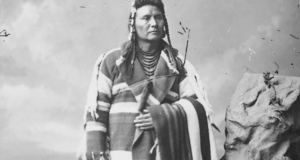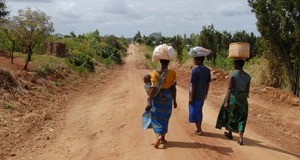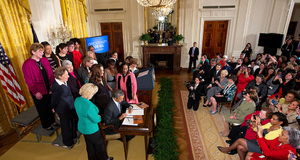From Discussions VOL. 11 NO. 2The Human Rights Impacts of VAWA 2013: A True Victory for Native American Women?AnalysisIt is dangerously easy to assume that since Native Americans won the 2013 VAWA reauthorization they have also achieved the proper human rights protection they deserve. However, political standards and human rights are far from the same. Upon closer reflection of how the VAWA reauthorization impacts Native American women’s specific human rights, it becomes apparent that the new Act is not complete victory for the native victims of sexual violence. The VAWA Reauthorization of 2013 only goes halfway to ensure the human rights of life, liberty and security of person for Native American women. While the new tribal provisions allow Native American communities much more sovereignty than previous versions of VAWA, there are still extreme jurisdictional limitations. For example, crimes between two strangers (including sexual assaults), crimes committed by a person who lacks sufficient ties to the tribe (e.g. living or working on its reservation), and child or elder abuse that does not involve the violation of a protection order are still out of tribal courts’ jurisdiction. Sarah Deer, a citizen of Muscogee (Creek) Nation and assistant law professor at William Mitchell College of Law, explains that the law will only apply to non-Indians who are married or in an intimate relationship with a tribal member, and it is limited to cases of domestic violence. Bruce Duthu, an internationally recognized scholar of Native American law and professor at Dartmouth College, points out that “The reauthorized VAWA goes part of the way by affirming tribal sovereignty over all offenders for a very limited class of offenses.” Furthermore, while the VAWA reauthorization gives tribal courts more sovereignty, it does nothing to address the concerning inadequacies of these tribal courts. According to Amnesty International, “Tribal law enforcement agencies are also chronically under-funded and federal and state governments provide significantly fewer resources for law enforcement on tribal land than they provide for comparable non-Native communities. The lack of appropriate training in all police forces—federal, state and tribal—also undermines survivors’ right to justice.” Tribal courts’ recently enlarged jurisdiction is currently regarded as a great victory, but it is important to remember that these tribal law enforcement systems do not presently have the necessary means to successfully pursue justice for victims. Furthermore, tribes yearning to take advantage of VAWA’s jurisdictional provisions must first enact many institutional changes, including amending current tribal codes, hiring new judges, and devoting resources to pay for public defenders. Thus, the VAWA reauthorization does not ensure Native American women’s right to recognition and equality everywhere as a person before the law. It is undeniable that Native American women still receive substandard legal protection and security compared to the protections other American women receive. As decreed by the United Nations, it is a human right to “an effective remedy by the competent national tribunals for acts violating the fundamental rights granted him by the constitution or by law.” The federal advisory bodies, equivalent to “national tribunals,” suggested that federal agencies responsible for investigating and prosecuting sexual violence in Indian Country need to prioritize these cases and improve the transparency of their processes. The councils also recommended that tribal authorities have jurisdiction over non-Native offenders in Indian Country. According to the White House, most of the committees’ suggestions are included in the reauthorized version of the Violence Against Women Act. However, the reauthorized Act does not dictate any necessary requirement for federal agencies to make sexual violence cases on tribal lands a priority. Furthermore, tribal authorities only have jurisdiction over some of the non-native offenders on tribal lands. Ultimately, Native Americans were not granted the full “effective remedy” that these interagency councils recommended. Another major limitation of the 2013 VAWA reauthorization is that Alaskan Native women are left out. As Native Americans and supporters across the country celebrate the VAWA reauthorization, the media has largely ignored the controversial provision that excluded Alaskan Native tribes from the tribal jurisdiction provisions. This new provision prevents Alaskan Native women from gaining the same benefits that all other Native American women in the United States now receive from the VAWA reauthorization. The cause of this disparity between Alaska Natives and Native Americans is differences in land ownership. In Alaska, tribes do not have reservations, so they cannot base claims of jurisdiction on reservation boundaries. Tragically, for the same reason, Native Alaskan women are probably in the most need of tribal sovereignty. There are currently 140 Alaskan villages with no state law enforcement. Because of the vast distances, weather conditions, and lack of state trooper posts in Alaska, law enforcement response times can be very slow to help. The only place many women can turn to for protection against gender violence is their tribe. Thus, Native Alaskan women’s human rights continue to be grossly violated. RecommendationsIn order to best protect Native American women’s human rights, VAWA needs to extend tribal jurisdiction to all crimes of gender violence that occur on tribal lands. As sovereign entities closest in physical distance to the actual crime, tribal courts are likely to be the most effective means of law enforcement and may be able to engage the community in efforts to prevent gender violence in the first place. Tribal courts undeniably care more about the wellbeing of victims, and the argument that tribal courts are incapable of producing impartial juries is unfair and discriminatory. Moreover, Native American tribes are privy to the collective human right of governing themselves, as decreed by the United Nations as, “indigenous peoples, in exercising their right to self-determination, have the right to autonomy or self-government in matters relating to their internal or local affairs.” In my opinion, a crime of gender violence which occurs on tribal land is an internal matter, no matter whether the offender is native or not. The loopholes in the justice system concerning the prosecution of non-natives are precisely what perpetuate the culture of rape on tribal reservations. In order to dismantle this cultural norm of sexual assault, it is critical that more federal funds from VAWA should go towards improving the tribal courts and law enforcement system so that they are actually effective. I also recommend that tribal court systems create stronger statutory laws. Sarah Deer states that “during the last century, various criminal codes have been written and signed into law by tribal legislatures—some much better than others. Statutes are sometimes out of date. In addition, some of the earliest tribal criminal codes were taken from “boilerplate” codes which were drafted by non-Indians. Over the past several years, [she has] reviewed over 100 tribal sexual assault laws. What [she has] found is that many tribal codes have weaknesses—and most of the time, these weaknesses are inconsistent with tribal traditional laws which served to protect women and children.” For example, some tribal codes require that a prosecutor prove that physical force was used to commit sexual assault and some even have a marital exemption clause. These standards of gender violence are outdated and, frankly, insulting to women. The sovereignty of tribal courts can only benefit Native American women if tribal laws are updated to efficiently protect native women’s human rights. If there is no sexual assault code in place at the tribal level, no justice can be found in tribal court. Furthermore, in order to equalize the treatment of Native American women and non-native women before the law, it is imperative to create a system to collect, analyze and disseminate crime and victimization data on tribal lands. There is currently no systematic national data collection effort focused on crime on reservations, whereas there are extensive programs for this purpose throughout the rest of the United States. It is very rare that federal, state, and local crime data reports even distinguish between offenses committed in Indian Country from those committed elsewhere. According to the National Institute of Justice’s Program of Research on Violence Against American Indian and Alaska Native Women, “The primary mechanisms for reporting crime data—the FBI’s Uniform Crime Reporting (UCR) program and the National Incident Based Reporting System (NIBRS)—do not include offenses committed on reservations or criminal and delinquency arrests and subsequent processing by federal agents (e.g., FBI, BIA, The Drug Enforcement Administration [DEA], Bureau of Alcohol, Tobacco, Firearms and Explosives [ATF], U.S. Immigration and Customs Enforcement [ICE]).” Collecting such information allows the government to anticipate, monitor, and prevent such criminal activity. The next VAWA reauthorization should create such a system so that Native American women can finally begin to receive the same protection against gender violence that all other American women receive. Ultimately, it is important to remember that the condition of Native American women today can be explained through history. The high rate of gender violence experienced by native women today at the hands of white men is almost a tradition of American society. In order to truly change such an ingrained problem, the attitude of an entire nation must be reformed. The VAWA reauthorization of 2013 represents a step in the right direction, but there is still much more to be done to safeguard native women’s human rights. References“Alaska Native Women Lose in Violence Against Women Act Renewal.” Alaska Dispatch. Accessed December 3, 2013. http://www.alaskadispatch.com/article/20130312/alaska-native-women-loseviolence-against-women-act-renewal. “America’s Dark Secret: Violence Against Natives.” Girls’ Globe. Accessed December 5, 2013. http://girlsglobe.org/2013/04/19/americas-dark-secret-violence-against-natives/. Austin, Emily. “Statement from Peace Over Violence,” December 9, 2013. https://webmail.duke.edu/index.php/mail. Boren Introduces Legislation to Combat Violence Against Native American Women: Rep. Dan Boren (D-OK) News Release. Lanham, United States: Federal Information & News Dispatch, Inc., March 7, 2012. http://search.proquest.com.proxy.lib.duke.edu/docview/926802763. Bubar, Roe, and Pamela Jumper Thurman. “Violence Against Native Women.” Social Justice 31, no. 4 (98) (January 1, 2004): 70–86. Burns, Rebecca. “VAWA: A Victory for Women—But Which Women?” In These Times, February 28, 2013. http://inthesetimes.com/article/14668/vawa_a_victory_for_womenbut_which_women/. Chekuru, Kavitha. “Violence Against Women Act Includes New Protections For Native American Women.” Huffington Post, March 10,1920. http://www.huffingtonpost.com/2013/03/10/violence-againstwomen-act-native-americans_n_2849931.html. Comas-Diaz, Lillian, and Beverly Greene. Psychological Health of Women of Color: Intersections, Challenges, and Opportunities. ABCCLIO, 2013. Crossland, Christine, Jane Palmer, and Alison Brooks. “NIJ’s Program of Research on Violence Against American Indian and Alaska Native Women.” Violence Against Women 19, no. 6 (June 1, 2013): 771–790. Duthu, Bruce. Shadow Nations: Tribal Sovereignty and the Limits of Legal Pluralism. Oxford University Press, 2013. http://www.oxfordscholarship.com/view/10.1093/acprof:oso/9780199735860.001.0001/acprof-9780199735860. Duthu, N. Bruce. “Broken Justice in Indian Country.” The New York Times, August 11, 2008, sec. Opinion. http://www.nytimes.com/2008/08/11/opinion/11duthu.html. Fletcher, Matthew L. M. “David Perez on Why GOP Is Wrong on Constitutionality of Tribal Court Provisions in VAWA Reauthorization.” Turtle Talk. Accessed December 3, 2013. http://turtletalk.wordpress.com/2013/02/26/david-perez-on-why-gop-is-wrong-onconstitutionality-of-tribal-court-provisions-in-vawa-reauthorization/. “Navajo President Lauds Passage of VAWA Reauthorization.” Turtle Talk. Accessed December 3, 2013. http://turtletalk.wordpress.com/2013/02/28/navajo-president-lauds-passage-of-vawareauthorization/. “UN Human Rights Press Release: UN Experts Call for VAWA Reauthorization.” Turtle Talk. Accessed December 3, 2013. http://turtletalk.wordpress.com/2013/02/20/un-human-rights-press-releaseun-experts-call-for-vawa-reauthorization/. King, Winter. “Navigating VAWA’s New Tribal Court Jurisdictional Provision.” Text. Indian Country Today Media Network.com, March 31, 2013. http://indiancountrytodaymedia network.com/opinion/navigating-vawas-new-tribal-court-jurisdictional-provision-148458. Kpolisse. “Native Women Warriors Lobby for Pro-Tribal VAWA.” Text. Indian Country Today Media Network.com, June 27, 2012. http://indiancountrytodaymedianetwork.com/2012/06/27/native-womenwarriors-lobby-pro-tribal-vawa-120933. “Maze of Injustice.” Accessed December 4, 2013. http://www.amnestyusa.org/our-work/issues/women-s-rights/violence-againstwomen/maze-of-injustice. Mazecyrus. “Violence Against Women and Tribal Law.” Text. Indian Country Today Media Network.com, July 16, 2012. http://indiancountrytodaymedianetwork.com/2012/07/16/violence-againstwomen-and-tribal-law. “McCollum’s SAVE Native Women Act Empowers Tribal Communities to Effectively Combat Domestic Violence.” Accessed December 4, 2013. http://mccollum.house.gov/press-release/ mccollum%E2%80%99s-save-native-women-act-empowers-tribalcommunities-effectively-combat. Muhlhausen, David. “VAWA Amendment Does Not Fix the Problem.” The Foundry: Conservative Policy News Blog from The Heritage Foundation. Accessed October 1, 2013. http://blog.heritage.org/2013/02/26/violence-against-women-act-substitute-amendmentfails-to-address-the-underlying-problems/. “Native American Rights Fund,” n.d. http://www.narf.org/cases/vawa2013.html. News, Michelle Peirano Cronkite. “Violence Against Women Reauthorization Adds Protections for Tribal Women.” Accessed December 9, 2013. http://cronkitenewsonline.com/2013/02/violenceagainst-women-reauthorization-add-protections-for-tribal-women/. “No One Should Have to Live in Fear of Violence | The White House.” Accessed December 4, 2013. http://www.whitehouse.gov/blog/2013/03/07/no-one-should-have-live-fear-violence. “Obama Signs Violence Against Women Reauthorization Act.” ABC News Blogs. Accessed December 9, 2013. http://abcnews.go.com/blogs/politics/2013/03/obama-signs-violence-against-womenreauthorization-act/. Ortega, Debora, and Noël Busch-Armendariz. “In the Name of VAWA.” Affilia 28, no. 3 (August 1, 2013): 225–228. doi:10.1177/0886109913495644. Postmus, Judy. Sexual Violence and Abuse: An Encyclopedia of Prevention, Impacts, and Recovery. ABC-CLIO, 2012. “Rights Groups to GOP: Stop Watering Down the Violence Against Women Act.” Mother Jones. Accessed December 9, 2013. http://www.motherjones.com/mojo/2013/02/gop-vawa-bill-lgbt-undocumentedimmigrants. Seghetti, Lisa M., and Jerome P. Bjelopera. “The Violence Against Women Act: Overview, Legislation, and Federal Funding.” Congressional Research Service, May 10, 2012. http://www.fas.org/sgp/crs/misc/R42499.pdf. “Sexual Violence in the United States: Summary of the Roundtable Proceedings,” October 27, 2010. http://www.ovw.usdoj.gov/sexualviolence-report-march.pdf. “Violence Against Native Women Gaining Global Attention; Congress Encouraged to Act.” Text. Indian Country Today Media Network. com, October 11, 2012. http://indiancountrytodaymedianetwork.com/2012/10/11/violence-against-native-women-gaining-globalattention-congress-encouraged-act-139108. “Shannyn Moore: Alaska Politicians Stand in the Way of Protections | Shannyn Moore | ADN.com.” Accessed December 3, 2013. http://www.adn.com/2013/03/09/2819003/shannyn-moore-alaskapoliticians.html. Smith, Andrea. Conquest: Sexual Violence And American Indian Genocide. South End Press, 2005. “The Universal Declaration of Human Rights.” Accessed December 8, 2013. http://www.un.org/en/documents/udhr/. “United Nations.” Accessed December 9, 2013. http://www.un.org/en/. “USDOJ: Office on Violence Against Women: Tribal Communities.” Accessed October 1, 2013. http://www.ovw.usdoj.gov/tribal.html . “USDOJ: Tribal Justice and Safety: Publications.” Accessed October 1, 2013. http://www.justice.gov/tribal/vawa-tribal.html. “VAWA Tribal Jurisdiction Provision.” Belt Way Indian. Accessed December 3, 2013. http://beltwayindian.wordpress.com/2012/12/09/all-you-need-to-know-about-the-history-of-the-vawa-tribal-jurisdictionprovision/. “Violence Against Women Act Reauthorization Hailed in Indian Country.” MPR News. Accessed December 3, 2013. http://minnesota.publicradio.org/display/web/2013/03/07/law/violence-againstwomen-act-indian-country. Weisman, Jonathan. “Violence Against Women Act Held Up by Tribal Land Issue.” The New York Times, February 10, 2013, sec. U.S. / Politics. http://www.nytimes.com/2013/02/11/us/politics/violenceagainst-women-act-held-up-by-tribal-land-issue.html. Suggested Reading from Inquiries Journal
Inquiries Journal provides undergraduate and graduate students around the world a platform for the wide dissemination of academic work over a range of core disciplines. Representing the work of students from hundreds of institutions around the globe, Inquiries Journal's large database of academic articles is completely free. Learn more | Blog | Submit Latest in Women's & Gender Studies |



















